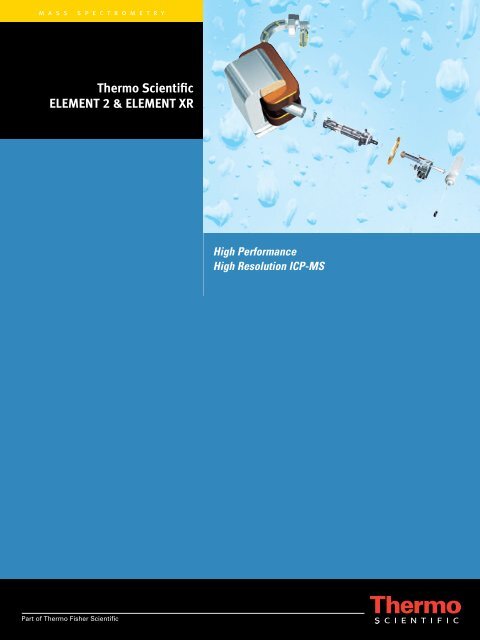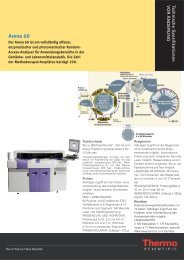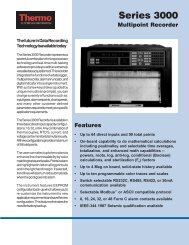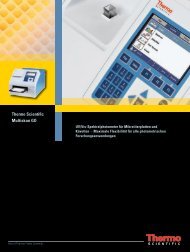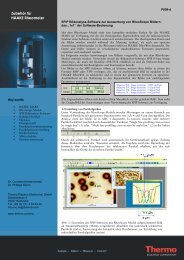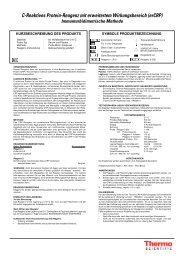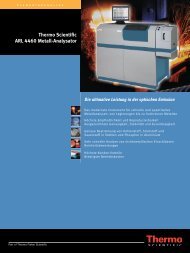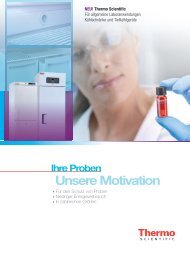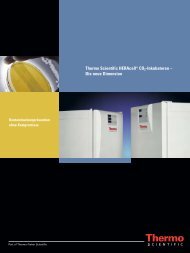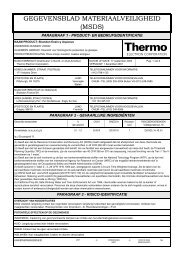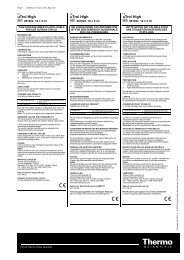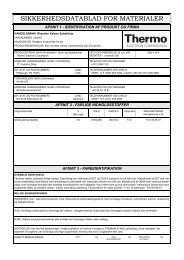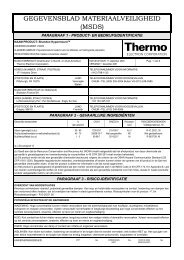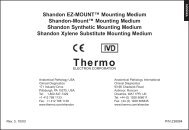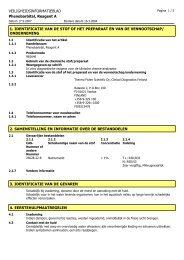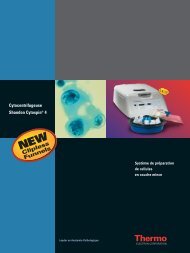Thermo Scientific ELEMENT 2 & ELEMENT XR
Thermo Scientific ELEMENT 2 & ELEMENT XR
Thermo Scientific ELEMENT 2 & ELEMENT XR
Create successful ePaper yourself
Turn your PDF publications into a flip-book with our unique Google optimized e-Paper software.
m a s s s p e c t r o m e t r y<br />
<strong>Thermo</strong> <strong>Scientific</strong><br />
<strong>ELEMENT</strong> 2 & <strong>ELEMENT</strong> <strong>XR</strong><br />
Part of <strong>Thermo</strong> Fisher <strong>Scientific</strong><br />
High Performance<br />
High Resolution ICP-MS
<strong>Thermo</strong> <strong>Scientific</strong> <strong>ELEMENT</strong> 2/<strong>XR</strong><br />
High Performance High Resolution ICP-MS<br />
<strong>Thermo</strong> <strong>Scientific</strong> <strong>ELEMENT</strong> 2/<strong>XR</strong><br />
High Performance High Resolution ICP-MS<br />
An Instrument for every Application<br />
A success story around the world with over 500 instruments<br />
installed, for example:<br />
Belgium: OCAS.<br />
Research centre for the application of steel<br />
with New Wave laser ablation system.<br />
www.ocas.be<br />
Canada: Seastar Chemicals Inc.<br />
A manufacturer of high purity chemicals<br />
with Dr. Brad McKelvey.<br />
www.seastarchemicals.com<br />
Germany: Institute for Transuranium Elements.<br />
Shown with a glovebox for radioactive<br />
sample measurements.<br />
http://itu.jrc.ec.europa.eu/<br />
Sweden: ALS Scandinavia AB.<br />
Scandinavia’s leading contract lab with<br />
Emma Engström.<br />
www.analytica.se<br />
USA: Micron Technology Inc.<br />
Advanced semiconductor solutions with<br />
Kevin Coyle.<br />
www.micron.com<br />
USA: Desert Research Institute.<br />
Hydrologic Sciences Division with<br />
Steve Lambert.<br />
www.dri.edu
Product Specification<br />
Specifications and Installation Requirements<br />
Sensitivity (Concentric Nebulizer) > 1 x 10 9 counts per second (cps)/ppm In<br />
Detection Power < 1 ppq for non-interfered nuclides<br />
Dark Noise < 0.2 cps<br />
Dynamic Range > 109 linear with automatic gain calibration (<strong>ELEMENT</strong> 2)<br />
> 1012 linear with automatic gain calibration (<strong>ELEMENT</strong> <strong>XR</strong>)<br />
Mass Resolution 300, 4000, 10,000 (10 % valley, equivalent to 5 % height);<br />
600, 8000, 20,000 (FWHM)<br />
Signal Stability < 1 % RSD over 10 minutes<br />
< 2 % RSD over 1 hour<br />
Scan Speed (magnetic) m/z 7 to 240 to 7 < 150 ms<br />
Scan Speed (electric) 1 ms/jump, independent of mass range<br />
Oxide and Doubly Charged Ions ratio measured<br />
BaO + /Ba + < 0.002<br />
Ba2+ / Ba + < 0.03<br />
Power 3-phase, 230/400 V ±10 %,<br />
50/60 Hz fused 32 A per phase<br />
Power consumption: ~9 kVA<br />
Environment Temperature 18 – 24 °C (64 – 75 °F)<br />
Humidity 50 – 60 %, noncondensing,<br />
non-corrosive<br />
Cooling Water ~ 200 l/h<br />
Temperature 10 – 20 °C<br />
4 – 6 bar (43 – 65 psi)<br />
Argon Purity 99.996 min.<br />
18 L/min<br />
Regulated pressure 8 –10 bar (116 –145 psi)<br />
Uninterrupted argon supply recommended<br />
Plasma Exhaust 1 x 6 cm Ø; 90 m3 /h<br />
(Argon + suspended sample)<br />
Electronics Exhaust 2 x 15 cm Ø; 800 m3 /h<br />
<strong>ELEMENT</strong> 2 and <strong>ELEMENT</strong> <strong>XR</strong>:, Footprint and Dimensions<br />
(all dimensions in cm)<br />
141<br />
79<br />
88<br />
63<br />
37<br />
125<br />
103<br />
67<br />
141 33<br />
174<br />
106<br />
36
<strong>Thermo</strong> <strong>Scientific</strong> <strong>ELEMENT</strong> 2/<strong>XR</strong><br />
High Performance High Resolution ICP-MS<br />
The Software Suite<br />
The <strong>ELEMENT</strong> 2/<strong>XR</strong> Software<br />
The <strong>ELEMENT</strong> 2/<strong>XR</strong> software controls and<br />
monitors all instrument functions for ICP-<br />
MS analysis. This includes data acquisition<br />
and auto-tuning of the <strong>ELEMENT</strong> 2/<strong>XR</strong>.<br />
The software also provides the full<br />
range of quantification procedures required<br />
in elemental analysis (qualitative,<br />
quantitative, semi-quantitative, isotope<br />
dilution) as well as isotope ratio and time<br />
resolved analysis modes.<br />
Controlling and Tuning<br />
• Autotuning of all parameters, including<br />
ICP parameters, torch position, lenses and<br />
multiplier voltage<br />
• Fully automated and configurable plasma<br />
start and stop sequence<br />
• Easy autosampler setup using a graphical<br />
display of the autosampler<br />
Setup of Methods<br />
• Intuitive and easy selection of target<br />
isotopes in periodic table or spreadsheet<br />
display modes<br />
• Automatic, customizable isobaric<br />
interference correction<br />
• Spreadsheet style ‘click-and-drag’ cell<br />
fill down<br />
Instrument Startup and Autosampler Control<br />
Creating and Running Sequences<br />
• Intuitive and easy creation of sample<br />
analysis sequences in graphical or<br />
spreadsheet display modes<br />
• Integrated powerful QA/QC package that<br />
meets internationally regulated<br />
requirements including US EPA 200.8 and<br />
6020. The flexible editor included can be<br />
used to define specific QA/QC criteria in<br />
any laboratory.<br />
•Remote Control & Diagnostic<br />
Displaying Results and Creation<br />
Displaying Results and Creation<br />
of Reports<br />
• Real time display of spectra, calibration<br />
curves, fully quantitative results and time<br />
resolved analyses<br />
• On-line export of time resolved data in<br />
several formats (ASCII, GRAMS,<br />
Spectacle, GLITTER, ANDI and Xcalibur ®<br />
for further analysis in third party programs<br />
•Setting & Read-Back of All Instrument Parameters<br />
The <strong>ELEMENT</strong> 2/<strong>XR</strong> software is a state-of-the-art, simple to use software suite taking advantage of the<br />
reliability and stability of Microsoft ® Windows ® XP Professional. The software package is optimized for<br />
the needs of the routine analyst, providing stability and ease of use for basic operation of the <strong>ELEMENT</strong><br />
2/<strong>XR</strong>, and yet retains the flexibility for advanced operation.<br />
Due to the use of the Microsoft Windows XP Professional operating system and standardized<br />
programming, the data system computer can be easily connected to a network, enabling data transfer<br />
and allowing remote control of the <strong>ELEMENT</strong> 2/<strong>XR</strong>.
• Multielement analysis across the periodic table covering<br />
a mg/L to sub pg/L concentration range<br />
– Compatible with inorganic and organic solution<br />
matrices and solids<br />
• High mass resolution to access spectrally interfered isotopes<br />
– Produces unambiguous elemental spectra<br />
• A multielemental detector for transient signals<br />
– For example, CE, HPLC, GC, FFF and laser ablation<br />
• High precision isotope ratios<br />
– Independent of interferences or interfered isotopes<br />
• Fully automated tuning and analysis<br />
– In conjunction with a comprehensive, customizable<br />
quality control system<br />
• Reliability and robustness to serve as a 24 / 7 production<br />
control tool<br />
– Highest sample throughput<br />
• Highest flexibility and accessibility to<br />
serve as an advanced research tool
<strong>Thermo</strong> <strong>Scientific</strong> <strong>ELEMENT</strong> 2/<strong>XR</strong><br />
High Performance High Resolution ICP-MS<br />
High Mass Resolution<br />
The unequivocal separation of analyte ions<br />
from spectral interferences is a prerequisite<br />
of accurate and precise analysis. High mass<br />
resolution is the universal means for this<br />
separation.<br />
Spectral interferences are the main<br />
limitation of ICP-MS. The argon plasma gas,<br />
water, acid and the sample matrix itself can<br />
combine to introduce a wide range of polyatomic<br />
ion species. The resultant interfering<br />
species may have the same nominal mass<br />
as an analyte ion and thus return a falsely<br />
high value for the analyte. Numerous<br />
strategies have been used in order to try to<br />
minimize or circumvent the formation of<br />
these spectral interferences. These include<br />
mathematical corrections, special sample<br />
introduction systems, special plasma<br />
parameters and collision/dynamic reaction<br />
cells to neutralize part of the interferences.<br />
High resolution with a sector-field mass<br />
spectrometer simply distinguishes the analyte<br />
from interference by difference in mass.<br />
The capability of high mass resolution is<br />
a feature unique to the <strong>ELEMENT</strong> 2/<strong>XR</strong><br />
product lines. This ability can be used for<br />
quantification and isotope ratio analysis for<br />
nearly the whole periodic table, and in<br />
almost all matrices.<br />
Even in a sample matrix as simple as<br />
ultra pure water (UPW), interferences<br />
do exist especially at low analyte<br />
concentration levels:<br />
28 Si<br />
12 C 16 O<br />
27.94 27.95 27.96 27.97 27.98<br />
Mass [u]<br />
27.99 28.00 28.01<br />
43.90<br />
30.94 30.95 30.96 30.97 30.98 30.99 31.00 31.01<br />
Mass [u]<br />
Phosphorus in UPW, Medium Resolution<br />
Silicon in UPW, Medium Resolution<br />
Calcium in UPW, Medium Resolution<br />
Zoom in<br />
31 P<br />
44 Ca<br />
28 Si 16 O<br />
15 N 16 O<br />
14 N 16 OH<br />
30.94 30.95 30.96 30.97 30.98 30.99 31.00 31.01<br />
Mass [u]<br />
43.92 43.94 43.96<br />
Mass [u]<br />
43.98 44.00<br />
14 N2<br />
12 C 16 O2
Ion Detection System<br />
Conversion<br />
Dynode<br />
Electrons<br />
e -<br />
Ions<br />
m +<br />
<strong>ELEMENT</strong> 2 Ion Detection System<br />
<strong>ELEMENT</strong> <strong>XR</strong> Ion Detection System<br />
analog<br />
counting<br />
12345<br />
SEM<br />
analog<br />
signal<br />
counting<br />
signal<br />
The goal of real life analysis is<br />
the simultaneous determination<br />
of major and trace elements.<br />
The <strong>ELEMENT</strong> 2 is equipped with a discrete<br />
dynode detection system that enables the<br />
quantification of both trace and major<br />
elements in a single analysis across a<br />
dynamic range of 109 .<br />
The <strong>ELEMENT</strong> 2 detector system<br />
incorporates a conversion dynode at -8 kV.<br />
The high acceleration to -8 kV results in a<br />
mass independent detector response,<br />
enabling fully automatic cross calibration<br />
between the counting and analog modes.<br />
No user interaction is necessary.<br />
The automatic cross calibration ensures a<br />
constantly updated detector response at all<br />
times – ready for the unexpected sample!<br />
Additionally the detector enables the<br />
measurement of large isotope ratios. With<br />
the minor isotope in counting mode and the<br />
abundant isotope in analog mode the highest<br />
precision and accuracy can be obtained.<br />
Another step ahead<br />
The most recent high resolution ICP-MS, the<br />
<strong>Thermo</strong> <strong>Scientific</strong> <strong>ELEMENT</strong> <strong>XR</strong>, opens<br />
another dimension of linearity in ICP-MS.<br />
Incorporating a single Faraday detector in<br />
addition to the discrete dynode detector offers<br />
> 12 orders of magnitude linear dynamic<br />
range. Herewith the dream of analyzing<br />
ultra-trace elements and matrix elements<br />
within the same analysis becomes true!<br />
Extremely short integration times of < 1<br />
ms in analog and Faraday mode, and 0.1 ms<br />
in counting mode in combination with a<br />
switching time of 1 ms between analog and<br />
faraday mode, makes the <strong>ELEMENT</strong> <strong>XR</strong> the<br />
perfect tool for transient signals such as<br />
those from laser ablation.<br />
Specifications<br />
Dynamic Range > 10 9 with automatic<br />
gain calibration (<strong>ELEMENT</strong> 2)<br />
Dynamic Range > 10 12 with automatic<br />
gain calibration (<strong>ELEMENT</strong> <strong>XR</strong>)
<strong>Thermo</strong> <strong>Scientific</strong> <strong>ELEMENT</strong> 2/<strong>XR</strong><br />
High Performance High Resolution ICP-MS<br />
Mass Stability<br />
The mature design of the<br />
<strong>ELEMENT</strong> 2 delivers the fastest<br />
scan speed ever for a magnetic<br />
sector field ICP-MS. With the<br />
<strong>ELEMENT</strong> 2 a jump from 7 to 240<br />
to 7 is realized in < 150 ms.<br />
Scanning<br />
Routine scanning is performed by a<br />
combination of magnetic and electric jumps.<br />
The <strong>ELEMENT</strong> 2/<strong>XR</strong> has the unique<br />
capability to scan +30 % from the magnet<br />
mass by decreasing the acceleration<br />
voltage. The magnetic field is kept constant<br />
while the acceleration voltage is varied.<br />
This ingenious combination of scan<br />
techniques delivers the fastest scanning<br />
ever realized by a sector field ICP-MS.<br />
Mass Stability<br />
The <strong>ELEMENT</strong> 2/<strong>XR</strong> guarantees the highest<br />
mass stability of any ICP-MS. This enables<br />
fast peak top jumping analyses rather than<br />
scanning across the whole peak, thus<br />
significantly decreasing analysis times. A<br />
combination of mature hardware and<br />
intelligent software guarantees mass<br />
stability in high resolution, which makes<br />
mass calibration a rare event.<br />
The synthesis of these characteristics<br />
combined with high sensitivity, allowing short<br />
integration times, makes the <strong>ELEMENT</strong> 2/<strong>XR</strong><br />
the fastest sector field ICP-MS ever.<br />
The scan speed of the <strong>ELEMENT</strong> 2 in<br />
combination with the high sensitivity<br />
opens the dimension of its use as a<br />
detector for fast transient signals.<br />
Specifications<br />
Mass stability: 25 ppm / 8 hours<br />
Magnetic scan speed: m/z 7 to 240 to 7 < 150 ms<br />
Coil Current (A)<br />
10<br />
9<br />
8<br />
7<br />
6<br />
5<br />
4<br />
3<br />
2<br />
1<br />
m/z 7-238<br />
75ms<br />
5ms 5 ms<br />
5ms 5ms<br />
5ms<br />
0<br />
0 50 100 150<br />
Time (ms)<br />
200 250<br />
Timing for a Full Magnet Cycle<br />
Centroid Mass<br />
77.921<br />
77.92<br />
77.919<br />
77.918<br />
77.917<br />
77.916<br />
77.915<br />
77.914<br />
77.913<br />
m/z 238- 7<br />
50ms<br />
m/z 7-238<br />
75ms<br />
Analysis<br />
y-scale is equivalent to peak width in high resolutiom<br />
12-Hour Mass Stability for 78 Se in high resolution<br />
m/z 238- 7<br />
50 ms<br />
Mass (m/z)<br />
238<br />
7
63.89 63.90 63.91 63.92 63.93<br />
Mass [u]<br />
63.94 63.95 63.96 63.97<br />
Zoom in<br />
Zinc in H 2 SO 4 (10 % w/w), High Resolution<br />
32 S 32 S<br />
Iron in Liquid Crystal Matrix, Cold Plasma, Medium Resolution<br />
Nickel Isotopes in Groundwater, Medium Resolution<br />
64 Zn<br />
32 S 16 O2<br />
63.89 63.90 63.91 63.92 63.93<br />
Mass [u]<br />
63.94 63.95 63.96 63.97<br />
59.88<br />
40 Ar 16 O<br />
56 Fe<br />
12 C2 16 O2<br />
55.80 55.85 55.90 55.95<br />
Mass [u]<br />
56.00 56.05 56.10<br />
44 Ca 16 O<br />
60 Ni<br />
43Ca16OH 32S16O12C 44 Ca 16 OH<br />
61 Ni<br />
59.90 59.92 59.94 59.96 59.98 60.88 60.90 60.92 60.94 60.96 60.98 61.88 61.92 61.92 61.94 61.96 61.98<br />
Mass [u]<br />
62 Ni<br />
46 Ca 16 O<br />
The more complex the sample matrix, the<br />
wider the range of interferences that will<br />
occur. The main advantage of high mass<br />
resolution as a technique to remove spectral<br />
interferences is that it is not just limited to a<br />
particular type of interference. With high<br />
mass resolution, iron at m/z 56 is easily<br />
separated in a simple matrix from 40 Ar 16 O as<br />
well as in more complex matrices from, for<br />
example, 40 Ca 16 O or 12 C 2 16 O2 .<br />
Arsenic at m/z 75 can be determined in<br />
HCl, separated from the 40 Ar 35 Cl<br />
interference, or, in a matrix containing Ca<br />
and chloride, from 40 Ca 35 Cl.<br />
Matrices such as mineral acids and<br />
organic solvents, which form a plethora of<br />
spectral interferences, can be easily<br />
analyzed using the high resolution mode.<br />
High resolution results in simple clear<br />
spectra and does not create new<br />
interferences.<br />
Resolution Specification<br />
(10 % peak valley definition)<br />
3 fixed resolutions:<br />
Low Resolution > 300<br />
Medium Resolution > 4000<br />
High Resolution > 10000
<strong>Thermo</strong> <strong>Scientific</strong> <strong>ELEMENT</strong> 2/<strong>XR</strong><br />
High Performance High Resolution ICP-MS<br />
Principle<br />
The <strong>ELEMENT</strong> 2 is a double<br />
focusing magnetic sector field<br />
ICP-MS.<br />
Plasma and Interface<br />
The argon plasma ion source and sampling<br />
interface of the <strong>ELEMENT</strong> 2/<strong>XR</strong> are at<br />
ground potential 1 . This enables the<br />
straightforward coupling of peripherals like<br />
HPLC, CE, GC and laser ablation. The<br />
interface reduces the initial kinetic energy<br />
spread from ~20 to ~5 eV by capacitively<br />
decoupling the plasma from the load coil,<br />
using a grounded guard electrode. This<br />
reduced energy spread increases the ion<br />
transmission and delivers superior<br />
sensitivities at all resolutions.<br />
The ion transfer optics focus the ions<br />
from the plasma interface on the entrance<br />
slit of the double focusing analyzer. The ion<br />
transfer optics are designed for low<br />
background, highest sensitivity and<br />
minimum mass bias at maximum stability 2 .<br />
High Resolution<br />
The <strong>ELEMENT</strong> 2/<strong>XR</strong> is able to fully<br />
automatically change between three fixed<br />
resolutions by switching the positions of the<br />
entrance and exit slits in < 1 s. The patented<br />
design of the fixed slit mechanism3 offers<br />
maximum stability and reproducibility of<br />
resolutions.<br />
1 Patent issued: US 5552599, GB 2282479<br />
2 Patent issued: US 5625185<br />
3 Patent issued: US 5451780, GB 2281438<br />
• Highly laminated, water cooled<br />
magnet, m/z: 7 - 240 - 7 in < 150 ms<br />
• 25 ppm/8 hour mass stability<br />
• Ion Transfer Optics<br />
Guarantees a flat response curve,<br />
low background and high sensitivity<br />
MR<br />
LR<br />
HR<br />
• 3 fixed resolutions:<br />
R = 300<br />
R = 4000<br />
R = 10000
Recovery [%]<br />
Intensity [cps]<br />
110<br />
100<br />
90<br />
80<br />
70<br />
60<br />
50<br />
concentration [ppt]<br />
120<br />
100<br />
80<br />
60<br />
40<br />
20<br />
0<br />
6.0<br />
5.8<br />
5.6<br />
5.4<br />
5.2<br />
5.0<br />
4.8<br />
4.6<br />
4.4<br />
4.2<br />
4.0<br />
5.1 ng/L As<br />
-5<br />
0 5 10 15<br />
Concentration [ppt]<br />
Standard Addition Analysis of Arsenic in HCl (10 % v/v)<br />
Cu Zr Ag Ba Tl Cr Mn Li Na Fe<br />
element<br />
1 ng/L Spike Recovery UPW<br />
Sn120(LR)<br />
2.5%<br />
Fe56(MR)<br />
2.2%<br />
As75(HR)<br />
4.1%<br />
Signal Stability 2 Hours Low,<br />
Medium and High Resolution: 5 ng/L<br />
1 2 3 4 5 6 7 8 9 10 11 12 13 14 15 16<br />
analysis #<br />
Signal Stability and Detection<br />
Limits<br />
Sector field ICP-MS offers superior ion<br />
transmission stability due to the high<br />
acceleration voltage (-8 kV) and excellent<br />
focusing properties.<br />
In combination with the high sensitivity,<br />
low background, interference-free<br />
measurements and an advanced sample<br />
introduction system, the <strong>ELEMENT</strong> 2/<strong>XR</strong><br />
delivers the lowest detection limits –<br />
independent of the sample matrix. The<br />
resulting low detection limits combined with<br />
highest stability at single digit ppt level enable<br />
quantification at the lowest concentrations.<br />
Stability Specifications<br />
< 1 % RSD in 10 minutes<br />
< 2 % RSD in 1 hour
<strong>Thermo</strong> <strong>Scientific</strong> <strong>ELEMENT</strong> 2/<strong>XR</strong><br />
High Performance High Resolution ICP-MS<br />
Sensitivity and Stability<br />
Sensitivity and Low Background<br />
It is obvious that the highest instrumental<br />
sensitivity is essential to achieve the lowest<br />
detection limits. However, it is the signal to<br />
noise ratio that dictates the detection limit.<br />
The <strong>ELEMENT</strong> 2/<strong>XR</strong> guarantees an off-peak<br />
background of < 0.2 cps for all three<br />
resolutions. Detection limits in the fg/L<br />
range are possible.<br />
Detection Limits in Complex<br />
Matrices<br />
Even in cases where the lowest detection<br />
limits are not the goal, the exceptionally<br />
high sensitivity of the <strong>ELEMENT</strong> 2/<strong>XR</strong> offers<br />
an important advantage. With the higher<br />
sensitivity, higher dilution factors for<br />
complex matrices can be used without<br />
sacrificing detection limits.<br />
Sensitivity and ‘Dilute and Shoot’<br />
The requirement for matrix separation for<br />
samples such as seawater, mineral acids or<br />
organic solvents is replaced by a simple<br />
dilution. Using this ‘dilute and shoot’<br />
approach, the matrix load on the sample<br />
introduction system, plasma and interface is<br />
reduced. This is also particularly important<br />
for the analysis of nuclear sample matrices<br />
where the minimization of waste is of<br />
paramount importance.<br />
Intensity [cps]<br />
0.8<br />
0.7<br />
0.6<br />
0.5<br />
0.4<br />
0.3<br />
0.2<br />
0.1<br />
0.0<br />
23Na 90Zr 107Ag 151Eu 47Ti 52Cr 63Cu 66Zn 79Br 75As 155Gd Normalized Intensity [ppq]<br />
6<br />
5<br />
4<br />
3<br />
2<br />
1<br />
0<br />
bkg
• Simultaneous measurement in analog<br />
and counting modes<br />
• > 10 9 linear dynamic range (<strong>ELEMENT</strong> 2)<br />
• > 10 12 linear dynamic range (<strong>ELEMENT</strong> <strong>XR</strong>)<br />
• < 0.2 cps dark noise<br />
• Fully automatic cross calibration<br />
• Interface at ground potential<br />
• Easily changeable cones<br />
• Resistant against chemicals<br />
• Torch with Guard Electrode (GE)<br />
The GE decreases the ion energy spread, thus increasing<br />
ion transmission. This and the high acceleration voltage<br />
used in a sector field ICP-MS results in increased<br />
sensitivity. The GE is also required for Cold Plasma<br />
measurements<br />
Mass Separation<br />
The magnetic field disperses ions according<br />
to their mass and energy. The magnet used<br />
in the <strong>ELEMENT</strong> 2/<strong>XR</strong> is specifically<br />
designed for use in ICP-MS applications. It is<br />
relatively small (sufficient for the mass range<br />
0 – 260 u), highly laminated and efficiently<br />
water-cooled for the highest mass stability.<br />
Changing of the magnetic field is controlled<br />
by a magnetic field regulator with a new<br />
high power stage, which delivers the fastest<br />
scan speed ever possible with a magnetic<br />
sector field instrument 4 .<br />
After passing through the magnetic field<br />
the ions enter the electrostatic analyzer for<br />
energy focusing. The combination of the<br />
magnetic and electrostatic fields results in the<br />
double focusing, high resolution properties of<br />
the <strong>ELEMENT</strong> 2/<strong>XR</strong>.<br />
Detection System<br />
The <strong>ELEMENT</strong> 2 is equipped with a discrete<br />
dynode detector system. Rather than having<br />
the ion beam directly strike the detector to<br />
initiate an electron cascade, the secondary<br />
electron multiplier implemented in the<br />
<strong>ELEMENT</strong> 2 uses a conversion dynode at -8<br />
kV, producing a uniform response across the<br />
mass range. The detector is linear over nine<br />
orders of magnitude – from ppq to ppm<br />
concentrations. The quantification of trace<br />
and major elements is therefore possible in<br />
a single analysis.<br />
Another step ahead<br />
The detection system of the <strong>ELEMENT</strong> <strong>XR</strong><br />
increases the linear dynamic range to > 1012 orders of magnitude by incorporating a<br />
single Faraday detector.<br />
4 <strong>Thermo</strong> <strong>Scientific</strong> Technical Note<br />
TN30074_E
<strong>Thermo</strong> <strong>Scientific</strong> <strong>ELEMENT</strong> 2/<strong>XR</strong><br />
High Performance High Resolution ICP-MS<br />
Resolution<br />
Low Resolution<br />
Low resolution (R = 300) is used for the<br />
analysis of non-interfered isotopes. In this<br />
mode the <strong>ELEMENT</strong> 2‘s sensitivity is the<br />
highest of all commercially available ICP-<br />
MS instruments. Additionally, the flat top<br />
peak shape is an advantage for high<br />
precision isotope ratio measurements.<br />
Medium Resolution<br />
Medium resolution (R = 4000) guarantees<br />
interference-free analysis for most elements<br />
in the majority of sample matrices. For<br />
example, transition elements are routinely<br />
measured in medium resolution due to the<br />
formation of many interfering polyatomic<br />
species in the mass range 24 – 70 u.<br />
High Resolution<br />
High resolution (R = 10000) is used for the<br />
analysis of elements in the most<br />
challenging sample matrices. For example,<br />
high resolution is used to separate As and<br />
Se from argon dimer interferences and<br />
argon chloride interferences in chlorine<br />
matrices, heavy rare earth elements from<br />
light rare earth element oxides in geological<br />
matrices, platinum group elements from<br />
argon-transition metal molecular species,<br />
and/or the oxides of Hf, Ta and W.<br />
Intensity [cps]<br />
350000<br />
300000<br />
250000<br />
200000<br />
150000<br />
100000<br />
50000<br />
0<br />
114.6 114.7 114.8<br />
100 ng/L 115 In, Low Resolution<br />
Intensity [cps]<br />
Intensity [cps]<br />
35000<br />
30000<br />
25000<br />
20000<br />
15000<br />
10000<br />
0<br />
6000<br />
5000<br />
40000<br />
30000<br />
20000<br />
10000<br />
0<br />
114.9<br />
Mass [u]<br />
114.88 114.89 114.90<br />
Mass [u]<br />
100 ng/L 115 In, Medium Resolution<br />
114.895 114.900<br />
100 ng/L 115 In, High Resolution<br />
115.0 115.1<br />
114.91 114.92<br />
114.905 114.910<br />
Mass [u]<br />
115.2
Intensity [cps]<br />
7000<br />
6000<br />
5000<br />
4000<br />
3000<br />
2000<br />
1000<br />
0<br />
0<br />
194.85<br />
52.0<br />
179 Hf 16 O<br />
195 Pt<br />
194.90 194.95<br />
Mass [u]<br />
195.00 195.05 195.10<br />
100 µg/L Hafnium, 100 ng/L Platinum, High Resolution<br />
Intensity [cps]<br />
60000<br />
50000<br />
40000<br />
30000<br />
20000<br />
10000<br />
52 Cr<br />
40 Ar 12 C<br />
Chromium in Blood, Medium Resolution<br />
Intensity [cps]<br />
250000<br />
200000<br />
150000<br />
100000<br />
50000<br />
0<br />
168.86<br />
53 Cr<br />
37 Cl 16 O<br />
52.2 52.4 52.6 52.8 53.0<br />
Mass [u]<br />
153 Eu 16 O<br />
169 Tm<br />
168.88 168.90 168.92 168.94 168.96 168.98 169.00<br />
Mass [u]<br />
Thulium in Europium Matrix, High Resolution<br />
Since the change in mass resolution is<br />
achieved by changing the width of the<br />
entrance and exit slits of the mass<br />
spectrometer, the instrumental sensitivity<br />
of a high resolution ICP-MS is dependent<br />
on the resolution mode used. Therefore,<br />
the <strong>ELEMENT</strong> 2/<strong>XR</strong> with three fixed<br />
resolutions has three sensitivities: the wider<br />
the slit, the higher the sensitivity.<br />
Fixed sensitivity ratio between resolutions:<br />
independent of mass and matrix.<br />
Even in high resolution mode, the intrinsic<br />
sensitivity of the <strong>ELEMENT</strong> 2/<strong>XR</strong> provides<br />
sub ppt detection limits.<br />
Sensitivity Specification<br />
Low Resolution (R = 300)<br />
115In > 1x106 cps/ppb<br />
Medium Resolution (R = 4000)<br />
115In > 1x105 cps/ppb<br />
High Resolution (R = 10000)<br />
115In > 1.5x104 cps/ppb<br />
Background in all 3 resolutions < 0.2 cps
Plasma Capabilities from <strong>Thermo</strong> Fisher <strong>Scientific</strong><br />
The use of an Inductively Coupled Plasma<br />
source (ICP) is the accepted and most<br />
powerful technique for the analysis and<br />
quantification of trace elements in both solid<br />
and liquid samples. Its applications range<br />
from routine environmental analyses to the<br />
materials industry, geological applications to<br />
clinical research and from the food industry<br />
to the semiconductor industry.<br />
<strong>Thermo</strong> Fisher <strong>Scientific</strong> is the only<br />
instrument manufacturer to offer the full<br />
range of Inductively Coupled Plasma<br />
Spectrometers (ICP, Quadrupole and Sector<br />
Field ICP-MS) to satisfy every aspect of<br />
plasma spectrometry from routine to highly<br />
demanding research applications.<br />
<strong>Thermo</strong> <strong>Scientific</strong><br />
iCAP ICP<br />
<strong>Thermo</strong> <strong>Scientific</strong><br />
<strong>ELEMENT</strong> 2/<strong>XR</strong> Sector Field ICP-MS or<br />
<strong>ELEMENT</strong> GD Glow Discharge ICP-MS<br />
Develop your lab from the easy-to-use<br />
<strong>Thermo</strong> <strong>Scientific</strong> iCAP ICP to the high<br />
performance <strong>Thermo</strong> <strong>Scientific</strong> XSERIES 2<br />
Quadrupole ICP-MS and up to the ultrasophisticated<br />
<strong>ELEMENT</strong> 2 and NEPTUNE<br />
Sector Field ICP-MS instruments. Each<br />
instrument combines leading-edge<br />
technology, fit for purpose and affordability<br />
with a tradition of quality, longevity,<br />
accuracy and ease of use.<br />
For direct analysis of conductive<br />
materials down to the parts per billion<br />
(ppb), <strong>Thermo</strong> Fisher <strong>Scientific</strong> also offers<br />
Glow Discharge technology: the <strong>Thermo</strong><br />
<strong>Scientific</strong> <strong>ELEMENT</strong> GD.<br />
<strong>Thermo</strong> <strong>Scientific</strong><br />
XSERIES 2 ICP-MS<br />
<strong>Thermo</strong> <strong>Scientific</strong><br />
NEPTUNE Multicollector ICP-MS<br />
In addition to these offices, <strong>Thermo</strong><br />
Fisher <strong>Scientific</strong> maintains a network<br />
of representative organizations<br />
throughout the world.<br />
Africa<br />
+43 1 333 5034 127 • analyze.emea@thermo.com<br />
Australia<br />
+61 2 8844 9500 • analyze.au@thermo.com<br />
Austria<br />
+43 1 333 50340 • analyze.at@thermo.com<br />
Belgium<br />
+32 2 482 30 30 • analyze.be@thermo.com<br />
Canada<br />
+1 800 530 8447 • analyze.ca@thermo.com<br />
China<br />
+86 10 8419 3588 • analyze.cn@thermo.com<br />
Denmark<br />
+45 70 23 62 60 • analyze.dk@thermo.com<br />
Europe-Other<br />
+43 1 333 5034 127 • analyze.emea@thermo.com<br />
France<br />
+33 1 60 92 48 00 • analyze.fr@thermo.com<br />
Germany<br />
+49 6103 408 1014 • analyze.de@thermo.com<br />
India<br />
+91 22 6742 9434 • analyze.in@thermo.com<br />
Italy<br />
+39 02 950 591 • analyze.it@thermo.com<br />
Japan<br />
+81 45 453 9100 • analyze.jp@thermo.com<br />
Latin America<br />
+1 608 276 5659 • analyze.la@thermo.com<br />
Middle East<br />
+43 1 333 5034 127 • analyze.emea@thermo.com<br />
Netherlands<br />
+31 76 579 55 55 • analyze.nl@thermo.com<br />
South Africa<br />
+27 11 570 1840 • analyze.sa@thermo.com<br />
Spain<br />
+34 914 845 965 • analyze.es@thermo.com<br />
Sweden / Norway/Finland<br />
+46 8 556 468 00 • analyze.se@thermo.com<br />
Switzerland<br />
+41 61 48784 00 • analyze.ch@thermo.com<br />
UK<br />
+44 1442 233555 • analyze.uk@thermo.com<br />
USA<br />
+1 800 532 4752 • analyze.us@thermo.com<br />
www.thermo.com<br />
<strong>Thermo</strong> Fisher <strong>Scientific</strong> (Bremen) GmbH<br />
is certified DIN EN ISO 9001:2000<br />
©2008 <strong>Thermo</strong> Fisher <strong>Scientific</strong> Inc. All rights reserved.<br />
Microsoft and Windows are registered trade marks of<br />
the Microsoft Corporation. All other trademarks are the<br />
property of <strong>Thermo</strong> Fisher <strong>Scientific</strong> Inc. and its<br />
subsidiaries.<br />
Specifications, terms and pricing are subject to change.<br />
Not all products are available in all countries. Please<br />
consult your local sales representative for details.<br />
BR30027_E 11/08C


